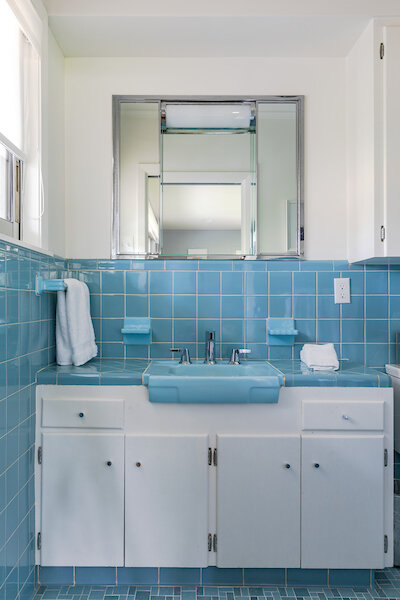Everyone knows at least one person who has pulled out beautiful mid-twentieth century porcelain bathroom tiles or painted brick whose color they thought was passé! Why? To replace it with cheap ceramic tiles found at a big box home improvement store or, finding themselves having to pay to repaint their exterior walls every ten years after it never had even one coat of paint for over sixty years! Leaving original finishes in a vintage building and leaning into its pallet by changing other things such as paint color or even furniture or towels is much more valuable both today and tomorrow as the home transitions from vintage to historic.
We may be known for contemporary architecture at SO Studio but just as we love buildings of their time and place, we love historic preservation projects. SO Studio has restored buildings from colonial Lousiana buildings such as the new visitors center in Carencro to mid-twentieth century buildings. We’ve even rehabilitated Victorian turn-of-the-twentieth-century buildings to roaring nineteen twenties Arts and Crafts buildings. The most misunderstood and undervalued of these by far are the mid-twentieth century ones. Recently SO Studio finished restoring a 1958 home in Bendel Gardens on the Vermilion River that is featured in the latest issue of Lousiana Life Magazine, the Sonnier Residence.
Although the house needed major restoration such as correcting the smiling, leaking asbestos roof and the sagging ceilings, many of the defining mid-century features were not only saved but in many cases restored and celebrated. These features of the house are important in historic preservation because they were so evocative of the era. Open floor plans with kitchens and bathrooms packed with bells and whistles were so typical of the time. This was new and innovative in post world war America. Unfortunately many people who buy or inherited a mid-twentieth-century home go right for changing the features that defined the period the most; the brick veneer and the embellished, yet highly practical, bathrooms and kitchens.
Four-inch by four-inch square porcelain tiles were so popular in the early modern era yet so many people seem to ditch the expensive porcelain tile for cheap ceramic tile they can get at the big box hardware store. In our Bendel restoration, we not only saved the original pink tile but our client spent considerable time and money searching out the closest match to replace a wall that had been retiled at some point in white. To better balance the pink we selected a wallpaper that felt 1950’s yet new and contrasted with the pink; with a navy background and green palm leaves. In the black and yellow tile bathroom, we simply leaned further into it by painting all of the walls, ceiling, and trim black.
As for the kitchen, minor changes were made to the cabinets to fit today’s appliances but other than this and replacing the countertops which had worn, the original cabinets were refinished on the faces and the pulls and features like the foil and paper towel dispensers were polished and shined.
Wood paneling and accented brick or stone walls with large wood-burning fireplaces were also very typical of the atomic age. In the Sonnier residence, we see all of the above, topped out with the original terrazzo floor topping which we restored and repaired. Rather than painting brick white which some may have thought not the right color, we painted the soffits and facia bronze to bring out a better color in the brick.
So what did we change from the original house you may be asking? The shag carpet that was past its lifespan was replaced with more allergy-friendly wood floors. Aged wallpaper was replaced with new wallpaper. Now, out-of-code aluminum sliding windows and doors were replaced with closely matching aluminum sliding windows and doors that are energy-efficient, better functioning, and meet today’s wind codes. The budget was not spent to replace a whole kitchen and bath but rather on updates to energy-efficient plumbing fixtures (not the original tubs and sinks), replacing the failing roof and windows, painting, and just plain restoring original features to their former glory. We like the way this approach came out and we hope you do too!








